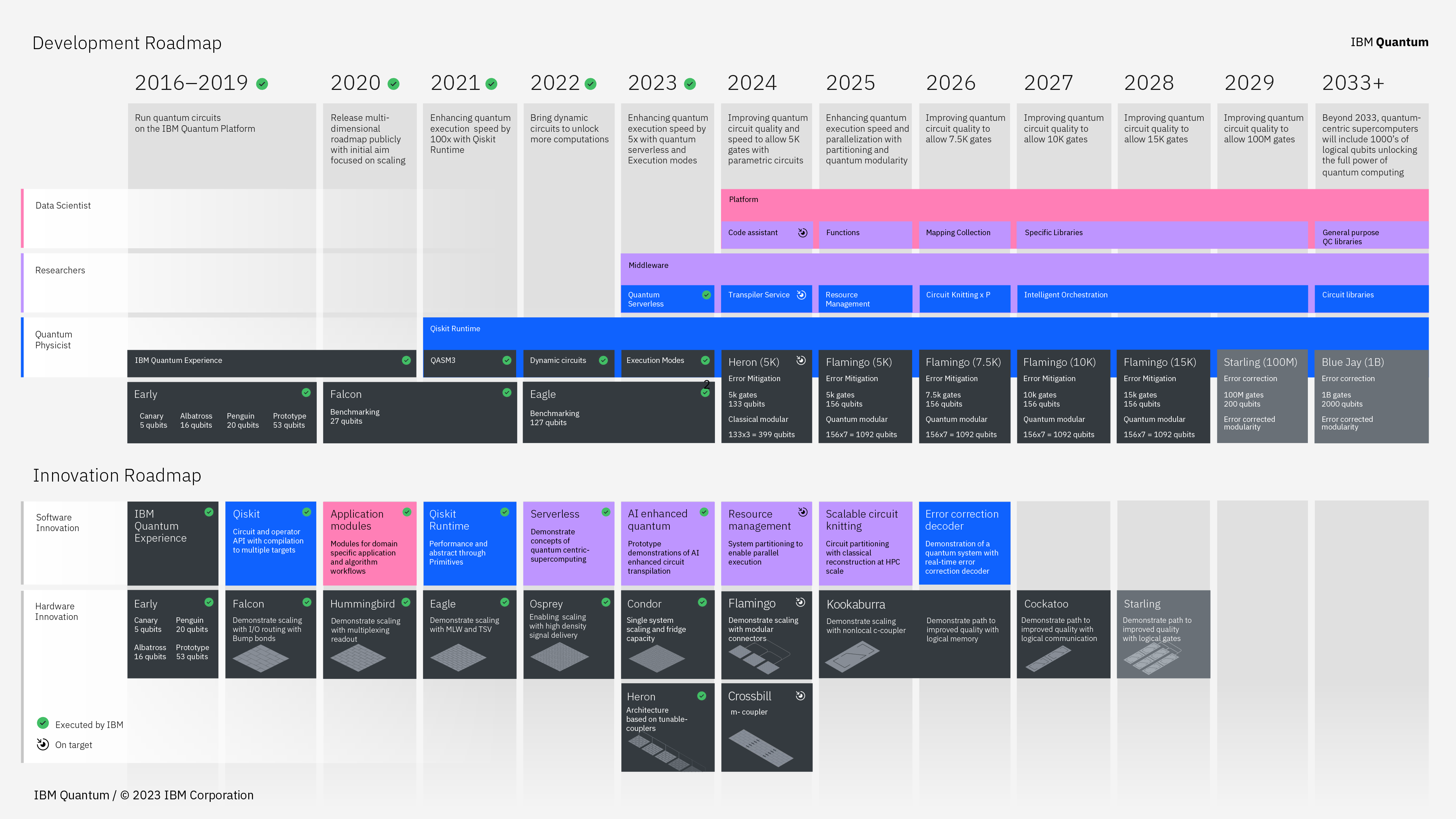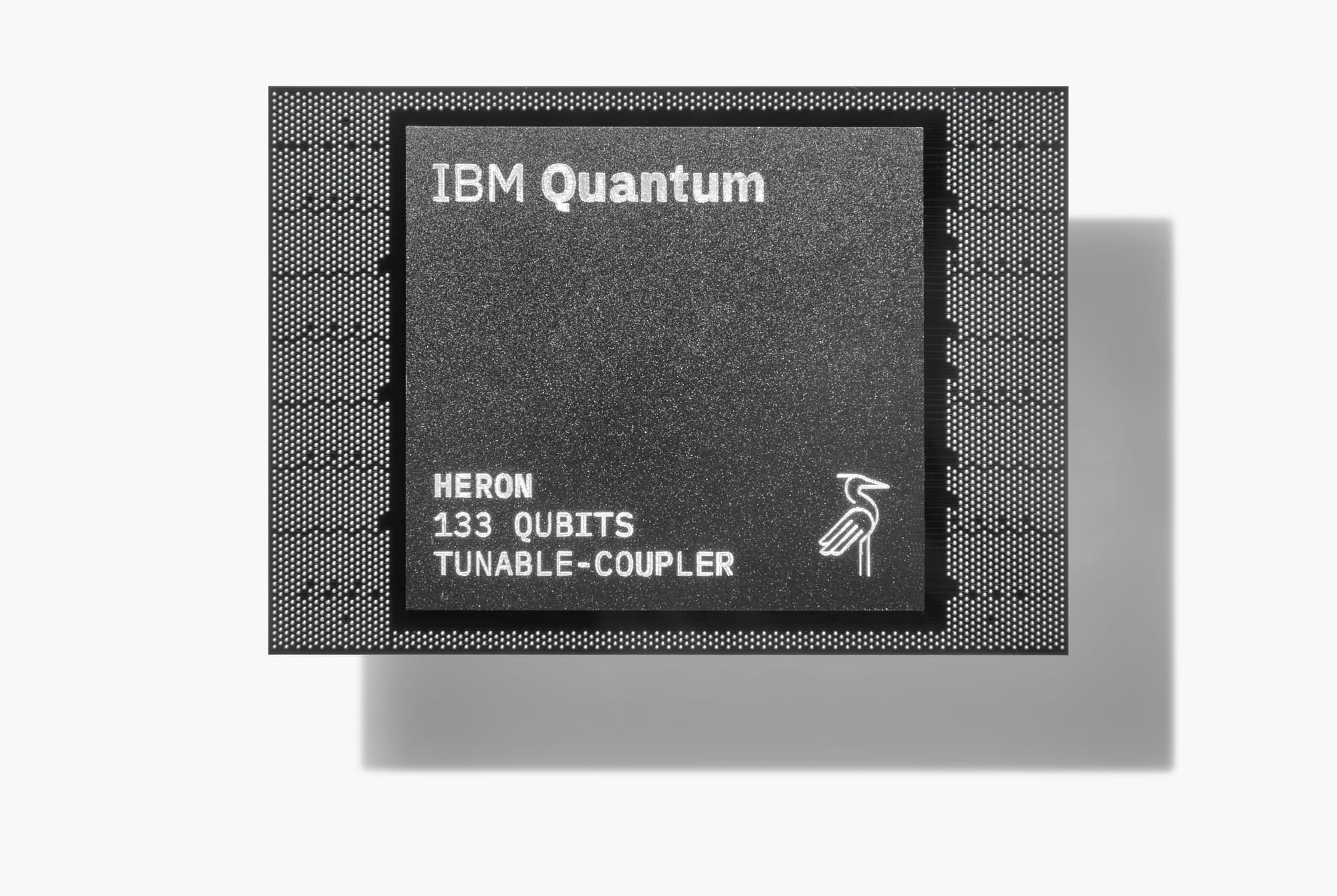IBM has revealed a new “utility scale” quantum processor, a landmark modular quantum computer, and teased the coming release of Qiskit 1.0 – a significantly improved open source software development kit to build powerful quantum computing qubit circuits “with comparative ease.”
Extending its quantum computing roadmap out to 2033 meanwhile, Big Blue pledged to release a Blue Jay, a system capable of executing 1 billion gates across 2,000 qubits by 2033 – “a nine order-of-magnitude increase in performed gates since we put our first device on the cloud in 2016.”

The trio of releases, made at the annual IBM Quantum Summit in New York, come six months after the company said it successfully worked around the “quantum noise” that introduces errors in calculations, to get reliable results at a scale “beyond brute-force classical computation” – detailing that progress in a paper published in the journal Nature.
The techniques that enabled this represent a “foundational tool for the realization of near-term quantum applications” IBM said in June 2023.
A cryogenically crispy quantum computing refresher
Classical computing deploys “bits” that use the 0 and 1 vocabulary of binary code. Quantum computers use “qubits” that draw on two-state quantum-mechanical systems – the ability of quantum particles to be in “superposition”; two different states at the same time.
As IBM Research’s Edwin Pednault puts it: “A qubit can represent both 0 and 1 simultaneously – in fact, in weighted combinations; for example, 37%-0, 63%-1. Three qubits can represent 2^3, or eight values simultaneously: 000, 001, 010, 011, 100, 101, 110, 111; 50 qubits can represent over one quadrillion values simultaneously.”
Whilst classical computing circuits use ANDs and ORs and NOTs and XORs (binary gates) on which users build up higher level instructions, then support for languages like Java, Python, etc., quantum computers use different kinds of gates like CNOTs and Hadamards.
For quantum computing to work effectively, calculations need to keep going in superposition for the duration of the computational cycle.But they can easily be thrown off by noise ( “the central obstacle to building large-scale quantum computers”) which could stem from diverse sources including disturbances in Earth’s magnetic field, local radiation, cosmic rays, or the influence that qubits exert on each other by proximity.
This is in part tackled physically: signals for configuring and programming a quantum computer come from outside the machines, travel down coaxial cables where they are amplified and filtered, and eventually reach the quantum device with its qubits at ~0.015K (-273.135 degrees C) and noise tackled by minimising the exposure of the chips and cables to heat and electromagnetic radiation in all its forms, by minimizing device defects, by constantly improving the performance of the electronics, and by using all sorts of novel mathematical schemes to compensate for noise.
The Stack reviewed the three new releases and associated academic papers for our readers to distil precisely what IBM has/aims to achieve, as Dario Gil, IBM SVP and Director of Research pledged on December 4 to “further increase the quality of a utility-scale quantum technology stack.”
New IBM Quantum Heron chip

At the heart of its IBM Quantum System Two, a new modular quantum computer and “cornerstone of IBM's quantum-centric supercomputing architecture” is the new Quantum Heron 133-qubit processor. (This summer’s quantum achievements highlighted above were made on IBM’s previous generation of semiconductor, its Quantum Eagle.)
The Quantum Heron offers a five-times improvement over the previous records set by IBM Eagle when it comes to reducing errors, IBM said. It is making the new chips available for users today via the cloud with more of the chips to join a “utility-scale fleet of systems over the… next year.”
Join peers following The Stack on LinkedIn
Featuring 133 fixed-frequency qubits with tunable couplers, Heron yields a 3-5x improvement in device performance over its 127-qubit Eagle processors, and “virtually eliminates cross-talk” IBM’s Gil said, adding “we have developed a qubit and the gate technology that we’re confident will form the foundation of our hardware roadmap going forward.”
(A coupler helps determine the performance of a superconducting quantum computer. Tunable couplers link qubits and perform quantum computations by turning on and off the coupling between them.)
The chip is built with what’s known as a “heavy-hex” processor architecture in which “each unit cell of the lattice consists of a hexagonal arrangement of qubits, with an additional qubit on each edge.”
As analyst Paul Smith-Goodson notes: “The Heron’s modular architecture…is different from previous quantum processor architecture.
“The new architecture connects quantum processors to a common control infrastructure so that data can flow classically and in real time between the QPU and other chips in a multi-chip environment.
“It also uses a new multi-qubit gate scheme that is both faster and provides higher fidelity. The Heron is the first IBM chip to use the new architecture that allows multiple processors to be linked using classical couplers to permit classical parallelization” he added.
New modular IBM Quantum System Two

The new modular “IBM Quantum System Two” meanwhile combines what Big Blue described as “scalable cryogenic infrastructure and classical runtime servers with modular qubit control electronics.” As the building block for IBM's quantum computing roadmap, it will house IBM's future generations of quantum processors and be accessible via the cloud.
The system gets updated middleware too and after six years of development, IBM is gearing up for the release of Qiskit 1.0 early in Q1 2024. (Qiskit is an open-source SDK with extensive documentation for both the hardware and software layer and for working with quantum computers at the level of circuits, pulses, and algorithms that ships with has several domain specific application APIs on top of its core module.)
Qiskit 1.0
IBM touted what it described as “a stable Qiskit focused on programming with Patterns, plus new set of tools using AI to help write and optimize Qiskit and QASM3 code… the beta release of Quantum Serverless on the IBM Quantum Platform, to facilitate run remote execution Qiksit Patterns, in a quantum function style” – let’s unpack this quantum verbiage!
A stable Qiskit is self-explanatory: After six years as a core SDK Qiskit has become what IBM describes as the “lingua franca” of quantum computing – allowing programmers to “write circuits, then execute them on hardware from more than eight different hardware manufacturers.”
The 1.0 release adds stability, “major improvements” in memory footprint of circuits — a claimed 55% decrease in memory usage compared to summer 2022’s Qiskit 0.39 for example, and other improvements.
Qiskit patterns meanwhile are “a collection of tools to simply map classical problems, optimize them to quantum circuits using Qiskit, executing those circuits using Qiskit Runtime, and then postprocess the results” – the release of a serverless execution option means users won’t have to sit and wait over a stable network whilst a job is queued and executed but punt it out for managed execution, “leave, and come back when the results are ready for you”; combined, IBM thinks that these will democratise access to quantum computing and mean end-users do “not [need to] be fluent in quantum circuits to…utilize quantum computing.”
Quantum computing, of course, is not immune to the allure of LLMs and IBM is also shipping a generative AI code assistant called Qiskit Code Assistant, based on the IBM Granite 20-billion-parameter Code Qiskit model, which was trained with about 370 million text tokens, based on a large collection of Qiskit examples and designed to remove some of the heavy lifting for programmers as they explore the suite of new tools.
Qubits, meanwhile, remain some distance from being the go-to solution for traditional computational problems, but IBM has and continues to be a genuine trail-blazer in the quantum computing space and as this summer's research showed, is making significant progress. A tipping point will arrive and then, the world will likely change. Those interested in exploring the shape of things to come could do worse than start with Qiskit.









